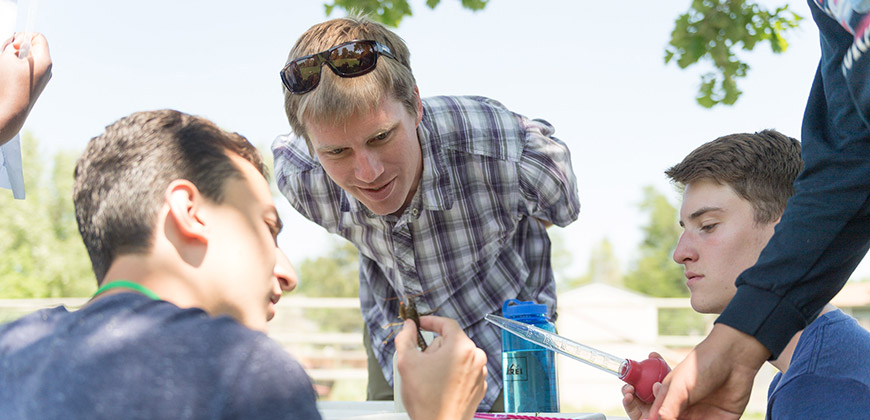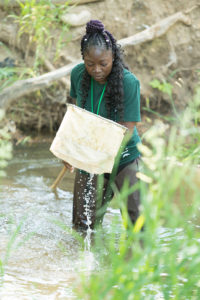
Assistant Professor Peter Nelson observes as high school students participate in a stream ecology field exercise in Spring Creek, at Edora Park.
You can learn a lot about the health of a water ecosystem by analyzing the diversity of fish and insect species found in it. Earlier this month, 10 high school students waded through Spring Creek sampling fish and insects as part of a summer outreach program in the Walter Scott, Jr. College of Engineering. The program’s aim is introducing underrepresented populations to science and engineering. The students participated in a full week of activities, but catching fish and bugs was one of the highlights.
The program is funded through a five-year National Science Foundation CAREER grant awarded to Peter Nelson, assistant professor in the Department of Civil and Environmental Engineering. CAREER awards are given “in support of the early career-development activities of those teacher-scholars who most effectively integrate research and education within the context of the mission of their organization.”

The focus of Nelson’s research is understanding how changes in sediment supply and water flow affect the mechanics of sediment transport in meandering rivers. His work has potential applications to river restoration projects; understanding how rivers organize their bed topography could predict suitable habitats for different aquatic species.
“The summer outreach program has helped students change their perspective on what science and engineering is and what they might be able to do with a STEM degree,” said Nelson.
Outdoor outreach and observation
Along with leading the stream ecology activity, Nelson guided the students through several other activities June 5-9, including surveying the creek behind the Lory Student Center, taking a tour of Water Works, and discussing the Colorado-Big Thompson Project while exploring Horsetooth Reservoir. He also introduced students to his work studying the effects of the 2012 High Park Fire on flooding and sedimentation at Skin Gulch, and facilitated experiments using a stream table at the Engineering Research Center.
“One thing that’s important for these students to learn is to go from observation to interpretation,” Nelson said. “Rather than look at something and jump to a conclusion, you have to decide what it is you’re actually able to see and observe, and from that draw conclusions.”
Throughout the week, Nelson reminded the students of this important concept, asking them to look at the landscape of Skin Gulch, for example, prompting them to identify what they could observe about flood water levels.
Connections for students
For Nelson, running the outreach program has solidified the importance of demonstrating real-world implications for doing research. Several participants have already expressed interest in studying water and pursuing careers in river science after being introduced to concepts during their week on campus.
“The type of research I do addresses practical, social, engineering, and research problems, and lends itself naturally to outreach opportunities like this one,” Nelson said.
Though the NSF will fund the program through 2020, Nelson hopes to continue it in future years. With help from CSU’s Alliance Partnership, Nelson has been able to more effectively recruit students to participate, as well as better assess success of the program and achievement of retention goals.